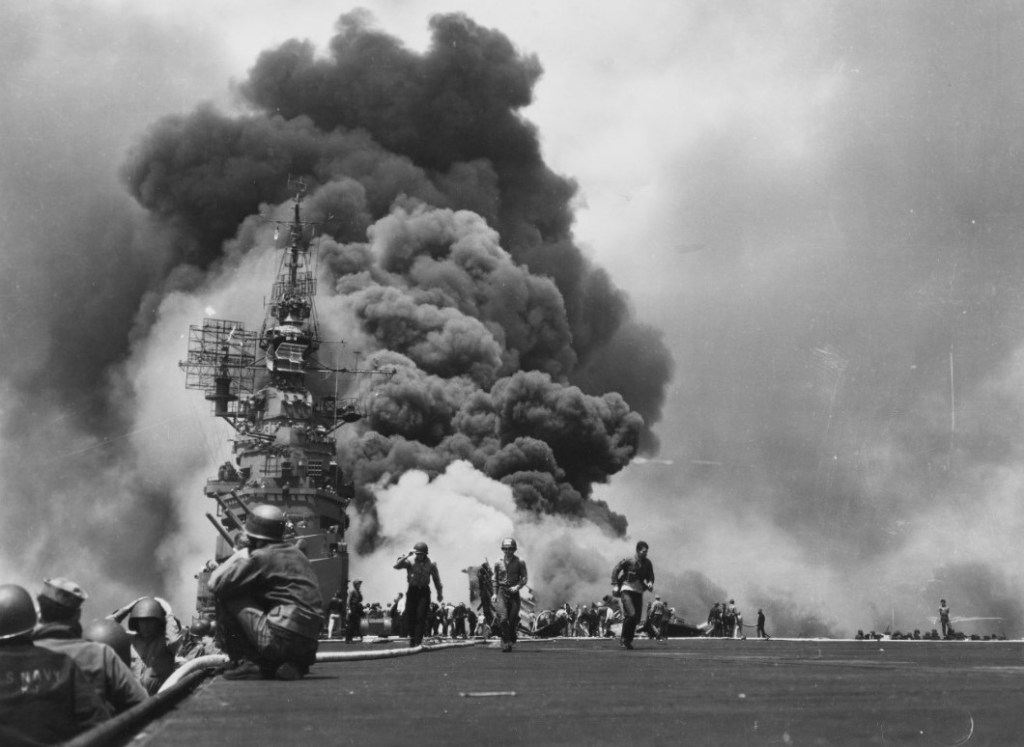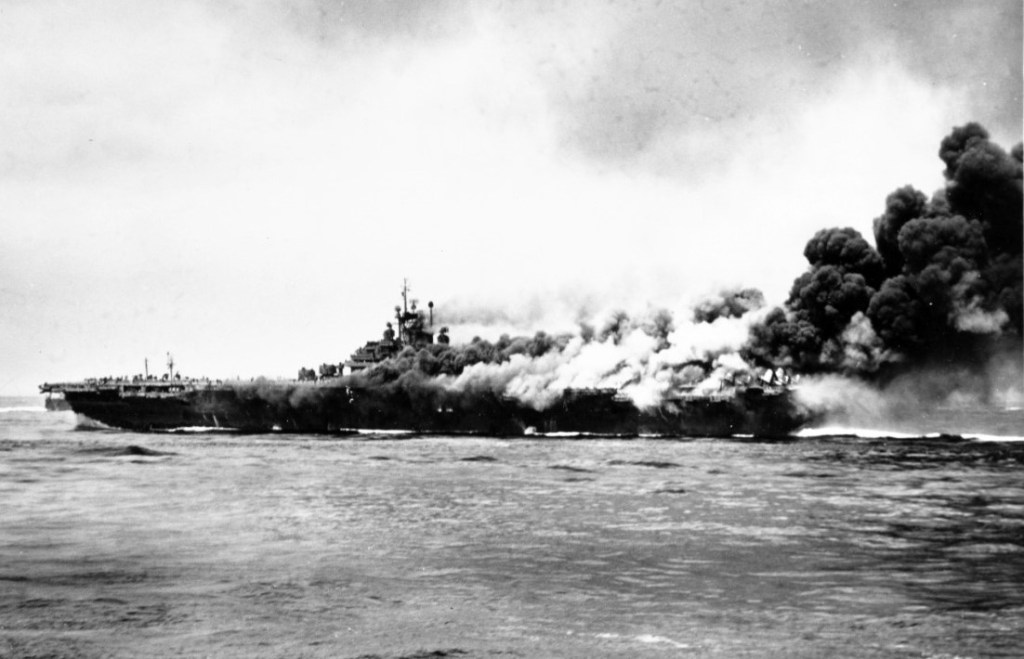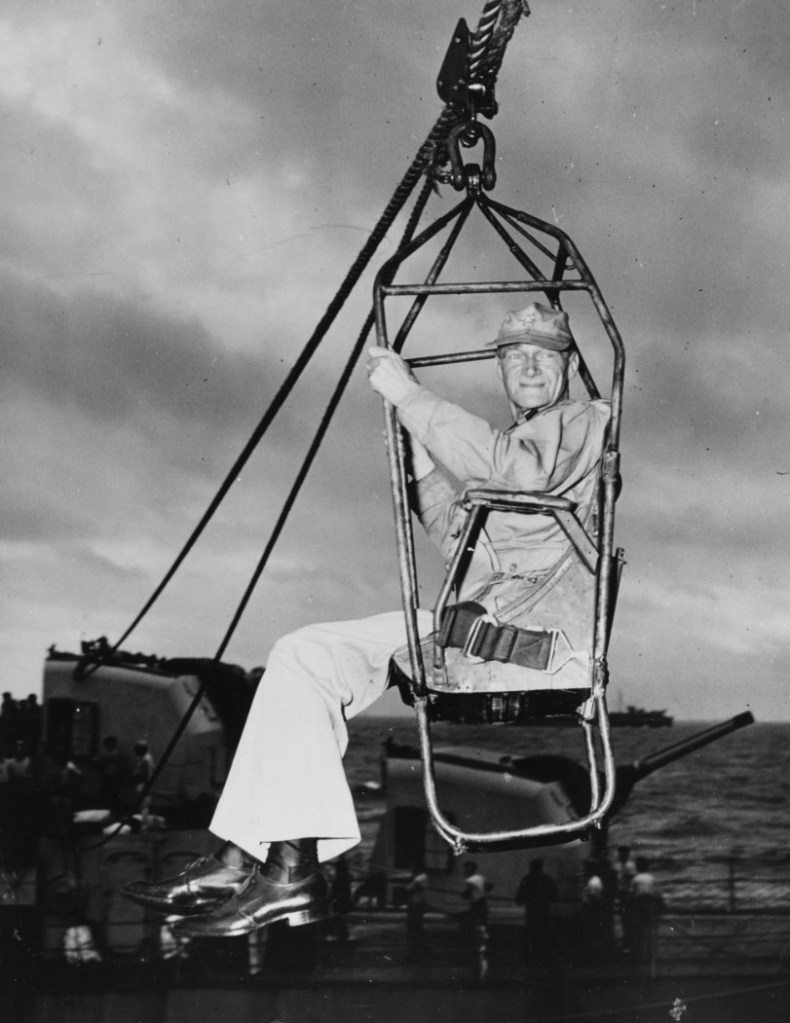The kicker headline on the Boston Globe front page for June 28, 1945 said it all: “NOW IT CAN BE TOLD”. In the time-bending world of wartime censorship, military authorities had deemed June 27 as the proper day to release the news that the USS Bunker Hill had incurred heavy damage and hundreds of casualties in a kamikaze attack on … May 11.
Details of the attack and the crew’s heroic effort in saving the ship dominated front pages the day after the release, bolstered by dramatic pictures of the burning carrier taken by Navy photographers. The headlines, though, focused on the awful numbers: 373 Americans dead, 264 wounded, 19 missing.

While many newspapers led with wire service reports of the official retelling, some were fortunate enough to be able to run a long-delayed eyewitness account from Phelps Adams of the New York Sun, complete with an eye-catching dateline. His story began this way:
Aboard a Fast Carrier in the Forward Pacific Area, May 11 [Delayed] — Two Japanese suicide planes carrying 1,100 pounds of bombs plunged into the flight deck of Vice Admiral Marc A. Mitscher’s own flagship early today killing several hundred officers and men and transforming one of our biggest flat-tops into a floating torch, with flames soaring nearly 1,000 feet in the sky.
For eight seemingly interminable hours that followed the ship and her crew fought as tense and terrifying a battle for survival as has ever been witnessed in the Pacific but when dusk closed in, the U.S.S. Bunker Hill — horribly crippled and still filmed by wisps of smoke and steam from her smoldering embers — was plowing along under her own power on the distant horizon — safe! Tomorrow she will spend another eight equally interminable hours burying at sea the men who died to save her. …
From the deck of the neighboring carrier a few hundred yards distant I watched the Bunker Hill burn, and I do not yet see how she lived through it. It is hard to believe that men could survive those flames, or that metal could withstand such heat. I still find it incredible, too, that death could strike so swiftly and so wholly unexpectedly into the very heart of our great Pacific fleet.

As Adams would note in his dispatch from the unnamed carrier — he was aboard the Enterprise — luck was on the Japanese pilots’ side. The men of the Bunker Hill had been in combat mode for 58 consecutive days, supporting operations off Iwo Jima, Okinawa, and beyond. The ship was not at general quarters when the attack came, the men not on watch finally permitted to relax.
It was at this precise moment that a keen-eyed man aboard our ship caught the first glimpse of three enemy planes and cried a warning. But before general quarters could be sounded on this ship, and before half a dozen shots could be fired by the Bunker Hill, the first kamikaze had dropped his 550-pound bomb and plunged squarely into the midst of the thirty-four waiting planes (on the carrier’s flight deck) in a shower of burning gasoline.
The bomb, fitted with a delayed action fuse, pierced the flight deck at a sharp angle, passed out through the side of the hull and exploded in mid-air before striking the water. The plane — a single-engined Jap fighter — knocked the parked aircraft about like ten-pins, sent a huge column of flame and smoke belching upwards and then skidded crazily over the side.
Some of the pilots were blown overboard, and many managed to scramble to safety, but before a move could be made to fight the flames another kamikaze came whining out of the clouds, straight into the deadly anti-aircraft guns of the ship. This plane was a Jap dive-bomber — a Judy. A five-inch shell that should have blown him out of the sky set him afire and riddled his plane with metal, but still he came. Passing over the stern of the ship, he dropped his bomb with excellent aim right in the middle of the blazing planes. Then he flipped over and torched through the flight deck at the base of the island.
A third Japanese attacker appeared soon after but a neighboring destroyer shot it down, ending the immediate threat. Now the fight was on to save the ship. As the crew fought the existing fires, new explosions kept popping off once the flames reached a fuel tank or ammunition stores. Eventually other ships were able to come alongside, “like fireboats in New York Harbor,” and help hose down the listing carrier. After about three hours the fires finally came under control, though they weren’t completely out.

“There were so many acts of outstanding heroism, it would be impossible to praise anyone over another,” the Bunker Hill‘s skipper, Capt. George A. Seitz, said in the Navy release on June 27. “I’m proud of every man who performed his assigned duties, and words can’t express our indebtedness to those gallant men who died at their posts below decks. They kept the boilers going and the pressure in the fire mains.”
By the end of May 11, Admiral Mitscher had left Seitz to nurse the Bunker Hill home and transferred to the Enterprise, making the “Big E” his new flagship. Mitscher had seen several of his staff killed and wounded in the attack. He was uninjured but arrived aboard the Enterprise, Adams observed, looking “tired and old and just plain mad. His deeply lined face was more than weather beaten — it looked like an example of erosion in the dust-bowl country — but his eyes flashed fire and vengeance.”
The Navy had suffered a significant loss, the flight deck of one of its carriers looking more like “the crater of a volcano,” Adams wrote. But the two-year-old ship was afloat and able to head back to Bremerton Navy Yard in Washington under her own power, her remaining crew still able to continue the fight.
“Perhaps her next task will be to cover the invasion of Tokyo itself,” Adams concluded his story. “Who knows?”
The Bunker Hill was still undergoing repairs when V-J Day arrived and she never saw battle again, though she did bring U.S. troops back from the Pacific theater before being decommissioned in January 1947.
Phelps Adams would return to the job he had held since 1928, serving as a Washington correspondent for the Sun, before joining U.S. Steel in 1950 after the newspaper shut down. He remained with the company through his retirement in 1967 and died in 1991.




Leave a comment